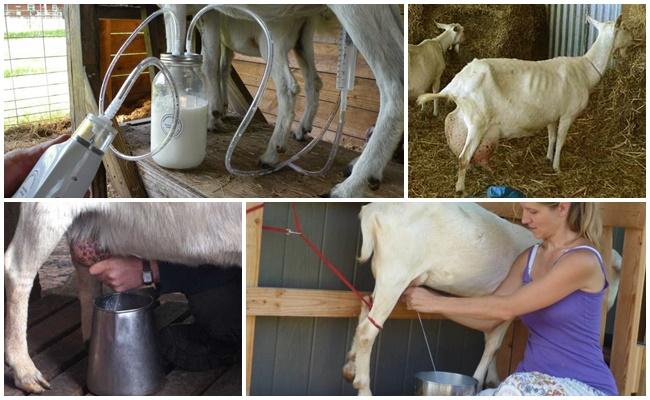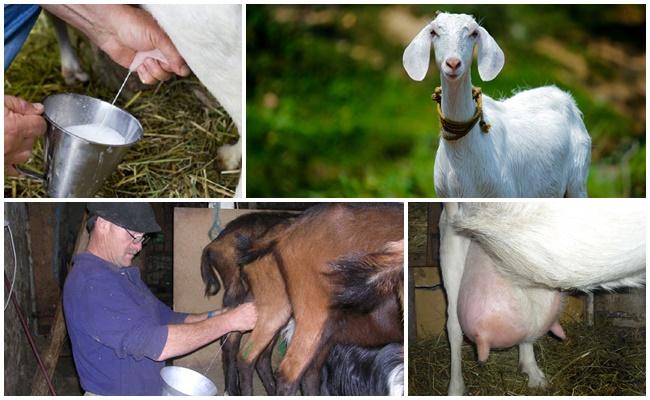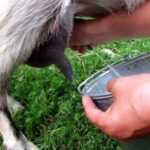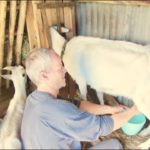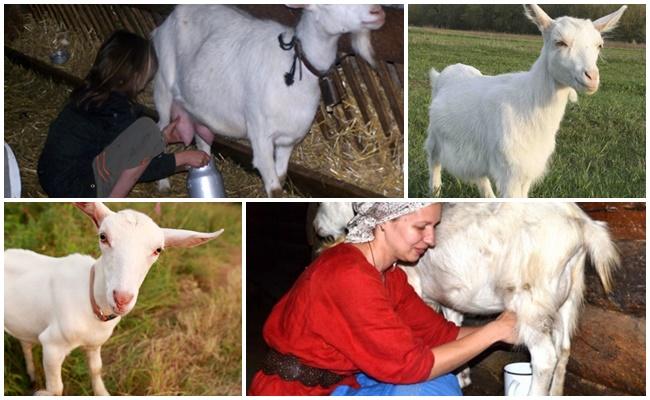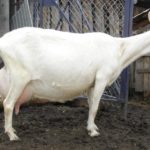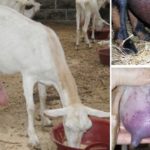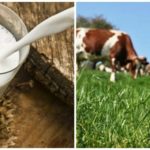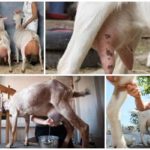It is important to know how to milk a goat properly. After all, the duration of lactation and the amount of milk depend on this procedure. The main thing is not to rush, that is, do not start milking the female ahead of schedule. It is advisable to wait until the first lambing. Immediately after birth, the udder begins to produce milk. It should be fed to goats up to 3 months of age. At the same time, you can express a small amount of milk for personal use.
Why milk a goat?
As a rule, goats are bred to produce milk. Lactation in animals begins after the birth of the first kid.It is advisable not to milk the female before giving birth. At a young age, all nutrients should go towards the development of the skeleton and various organs. The goat is covered only after it reaches 12-18 months. It is not recommended to carry out mating earlier. Pregnancy lasts another 5 months. During this period, they slowly begin to accustom the animal to human hands, that is, every day they spend a few minutes touching the goat’s udder and squeezing the nipples.
When a female gives birth to her young, she immediately produces colostrum. This is a substance with a high protein content, antimicrobial components and growth stimulants. Colostrum should be completely used to feed the kids. This substance disappears after 1-2 weeks, and regular milk appears instead. It should also be used to feed the kids. The cubs are fed with mother's milk until 2-3 months.
Immediately after the first lambing, the female begins to be milked little by little. The first milking is carried out immediately after birth in order to stimulate uterine contractions and improve the passage of the placenta. It is recommended to give colostrum to kids. The cubs can feed on their mother's milk and live under the goat for up to 2-3 months.
The kids should eat to their heart's content. The remaining milk must be expressed daily. It is recommended to ensure that nothing remains in the udder. Such an event will stimulate the production of more and more milk. After lambing, the goat is milked only after the kids have eaten (2-3 times a day). They do this so that she gives a lot of milk. If the female is not milked and this process is left to chance, then after a few months lactation may stop.
You can remove newly born kids from their mother, milk them with colostrum and then milk (by hand), and feed the kids from a bottle with a nipple. In this case, you need to immediately set a schedule. At first you need to milk the goat 5 times a day, after a week - 3 times a day, preferably at the same time. In this case, lactation will continue until the next lambing.
Udder preparation
You can’t just go up to a goat and milk it. This capricious animal may not even allow a person to approach it at first. It is necessary to accustom the female to touching during the first pregnancy, or rather, a month before lambing, but not earlier. The udder should be stroked, but not roughly massaged. You can imitate milking, squeeze the nipples (do not pull), wipe the udder with a warm, damp towel, and give your favorite goat treats (a piece of sugar) during a light massage. It is desirable that the goat enjoys this procedure.
Care and maintenance
During pregnancy, a goat that has not yet given birth should be fed with high-quality feed. Females are usually covered in the fall. Their pregnancy takes place during the winter months. During this period, the percentage of vitamins and nutrients in hay and vegetables decreases. A young goat needs to be fed with finely chopped carrots, Jerusalem artichoke, pumpkin, and beets. In winter, it is recommended to give spruce and conifer branches, pharmacy vitamins and minerals (E-selenium, vitamins D, A). The female should be kept in a clean, dry and warm room.
You need to feed a goat that has already given birth in a completely different way. This animal continues to produce milk even after mating. In the second month of pregnancy, the female needs to be started, that is, gradually stop milking. This is done so that all nutrients go to the development of the fetus, and not into milk. You cannot stop milking right away. The animal may develop mastitis.
The process of stopping lactation makes it easier to choose the right feed. The goats are kept on hay alone and are not given juicy vegetables and grains. The amount of water is also reduced. To maintain vitality, they give pharmacy vitamins and minerals and spruce branches. Then gradually increase the interval between milkings. Already a month after the start, the goats are milked not twice, but only once a day. And not completely, the udder is emptied only ¾ of the volume. A small amount of milk should remain.
Then the females are milked every other day, two or more. You need to constantly monitor the udder and, if necessary, express milk. 2 months before birth milking goats needs to be stopped completely. For a neglected female, the diet can be improved.
How to milk a goat after the first lambing
The first kitten is milked immediately after the birth of the cubs. A small amount of milk is expressed and given to the kids. Before milking, the udder is washed with warm water and dried with a clean towel. Cubs can suckle milk until 3 months of age.
Some breeders do not allow babies near the first heifer so that they do not damage the teats. In this case, immediately after lambing, the female should be milked 5 times a day, and the colostrum should be poured into bottles with a nipple and fed to the babies. After a week, you can milk the goat 3 times. The main thing is to milk the milk completely, every last drop, to stimulate milk production in the udder.
If the mother lives with the kids, unnecessary hassle can be avoided. True, it is advisable to milk a goat every day, otherwise she will get used to giving all the milk only to her cubs, and will be reluctant to share it with a person.
The owner of the goats decides for himself how the kids will eat. Each method has its own advantages. A female without kids will start milking faster and maintain lactation for a longer period. During milking, the goat needs to be given succulent food, grain, vegetables and root vegetables, minerals and vitamins, water with sugar.
Milk yield of a nulliparous goat
You can milk a nulliparous goat starting at 12 months of age. True, such a procedure is resorted to if there is no possibility of mating (there is no goat nearby) or the female is not capable of fertilization, that is, she is barren. It is advisable to cover a healthy goat and milk it after lambing.
Milking a nulliparous goat is carried out gradually. First of all, the animal’s diet is adjusted. The young female is given more juicy vegetables (carrots, turnips, pumpkin), boiled potatoes, green grass or silage in winter, and water with sugar. Pharmacy vitamins and minerals, diuretic herbs (chamomile, parsley, birch leaves) improve lactation. This diet stimulates milk production in the udder.
At first, the goat is simply given a massage. It is necessary to stroke the udder, squeeze the nipples, simulating the milking process. The procedure is carried out 2-3 times a day (daily, without breaks). After some time, a light liquid will appear, and then the milk itself.
Usually in dairy goats, virgin milk appears at 5-7 months. These are the consequences of good nutrition and hormones. True, they do not touch it or express it if the udder does not bulge too much.
How to milk a goat after a false pregnancy
After a miscarriage and false pregnancy, the female is milked as usual. These physiological processes are perceived by the body as normal childbirth, and the udder begins to produce colostrum, and then milk. Milking is carried out immediately after the fluid has drained from the uterus. This usually happens due to hormonal imbalance and poor nutrition. Subsequently, the goat can be covered again.
It is easier to milk a neglected female after a false pregnancy. They begin to milk her as before, that is, at first 5 times, and then 3 times a day. It is more difficult to milk a nulliparous goat. The animal will first have to be accustomed to hands and the milking process itself. After the end of a false pregnancy, milk should immediately arrive in the udder. They express him 5 times a day, then gradually switch to milking three times a day.
What do experts advise?
Milking of a goat is carried out only after birth. It is recommended to cover females no more than once a year. It is advisable to keep baby goats on milk feeding for up to 3 months. Switching too quickly to plant-based feeds can cause various diseases and non-viability of kids.
In newborn cubs, even the stomach is not adapted to digest grass or hay. With mother's milk, goat kids receive exactly the substances they need for normal development.
You should not expect large milk yields from a goat that has lambed for the first time. Initially, the female will give 1-2 liters of milk per day. After the second and third lambing, lactation will improve. Peak productivity will occur after 5 births. Dairy breeds will produce up to 4-6 liters of milk per day. By 9-10 years of age, milk yield will drop. It is recommended to replace old animals with young ones.

